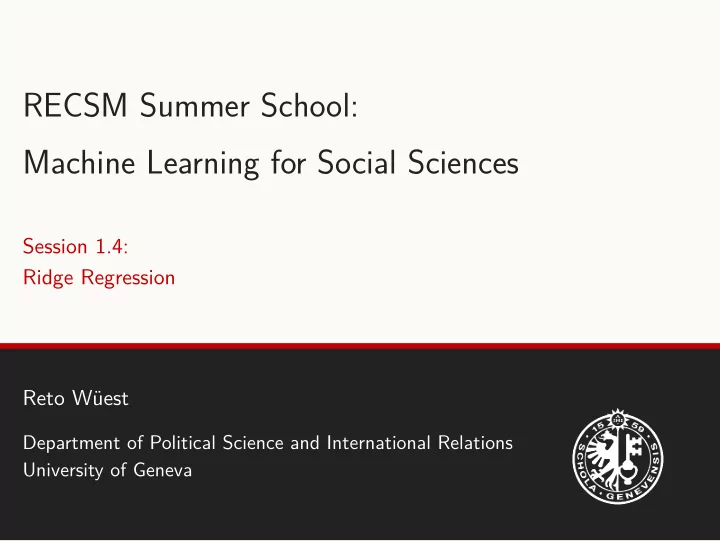

RECSM Summer School: Machine Learning for Social Sciences Session 1.4: Ridge Regression Reto Wüest Department of Political Science and International Relations University of Geneva 1
Shrinkage Methods
Shrinkage Methods • Shrinkage methods shrink the coefficient estimates of a regression model towards 0 . • This leads to a decrease in variance at the cost of an increase in bias. • If the decrease in variance dominates the increase in bias, this leads to a decrease in the test error. • The two best-known methods for shrinking regression coefficients are ridge regression and the lasso. 1
Shrinkage Methods Ridge Regression
Ridge Regression • When we fit a model by least squares, the coefficient estimates ˆ β 0 , ˆ β 1 , . . . , ˆ β p are the values that minimize 2 p n � � RSS = y i − β 0 − β j x ij . (1.4.1) i =1 j =1 • In ridge regression, the coefficient estimates are the values that minimize 2 p p p n � � � � β 2 β 2 y i − β 0 − β j x ij + λ j = RSS + λ , (1.4.2) j i =1 j =1 j =1 j =1 � �� � shrinkage penalty where λ ≥ 0 is a tuning parameter. 2
Ridge Regression • Tuning parameter λ controls the relative impact of the two terms on the coefficient estimates: • If λ = 0 , then the ridge regression estimates are identical to the least squares estimates. • As λ → ∞ , the ridge regression estimates will approach 0 . • Note that the shrinkage penalty is applied to β 1 , . . . , β p , but not to the intercept β 0 , which is a measure of the mean value of the response variable when x i 1 = x i 2 = . . . = x ip = 0 . 3
Ridge Regression • Least squares estimates are scale equivariant: multiplying predictor X j by constant c leads to a scaling of the least squares estimate by factor 1 /c (i.e., ˆ β j X j remains the same). • Ridge regression estimates can change substantially when multiplying a predictor by a constant, due to the sum of squared coefficients term in the objective function. • Therefore, the predictors should be standardized as follows before applying ridge regression x ij x ij = ˜ x j ) 2 , (1.4.3) � � n 1 i =1 ( x ij − ¯ n so that they are all on the same scale. 4
Shrinkage Methods Why Does Ridge Regression Improve Over Least Squares?
Why Does Ridge Regression Improve Over Least Squares? • As λ increases, the flexibility of ridge regression decreases, leading to increased bias but decreased variance. • Simulated data containing n = 50 observations and p = 45 predictors (test MSE is a function of variance and squared bias): 60 Mean Squared Error 50 40 30 20 1 0 0 1e − 01 1e+01 1e+03 λ (Squared bias (black), variance (green), and test MSE (purple) for the ridge regression predictions on a simulated data set. Source: James et al. 2013, 218.) 5
Why Does Ridge Regression Improve Over Least Squares? • When the relationship between the response and the predictors is close to linear, the least squares estimates have low bias but may have high variance. • In particular, when the number of predictors p is almost as large as the number of observations n (as in the above simulated data), the least squares estimates are extremely variable. • Hence, ridge regression works best in situations where the least squares estimates have high variance. 6
Recommend
More recommend